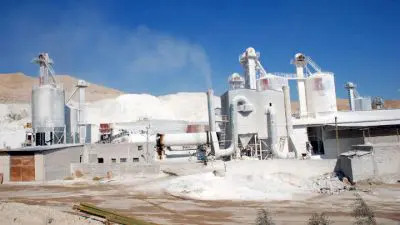Applications of gypsum in the construction industry include: surface coating, whitewashing, cleaning, polishing, plastering, gypsum mortar, thermal and acoustic insulation, prefabricated roof and floor sheets, sculpture, drywall, decor, Gypsum tile and so on

One of the primary uses of Plaster and gypsum in construction is for interior wall and ceiling finishing. Gypsum plaster, commonly known as plaster of Paris, is mixed with water to create a paste that can be applied smoothly on walls and ceilings. It provides a smooth, even surface that is ready for Painting or other decorative finishes. Plaster is widely used for creating decorative elements in buildings. Skilled craftsmen can use plaster to form intricate moldings, cornices, ceiling roses, and other ornamental details. These decorative plasterwork elements add aesthetic appeal and architectural character to interior spaces.
Plaster is commonly used in the repair and restoration of older buildings. Skilled craftsmen can use plaster to replicate and restore historic plasterwork and decorative elements. Plaster can be applied to damaged walls and ceilings to restore their original appearance. Gypsum-based products, such as gypsum boards, can contribute to soundproofing and acoustic control in buildings. Gypsum boards with specific compositions and thicknesses can help reduce sound transmission between rooms and provide better acoustic performance in spaces such as theaters, recording studios, or conference rooms.
The main consumption of plaster is in construction industry. Plaster is used in the building in two forms: Clay plaster and whitewashing plaster. Composite plasters, like Gipton plaster, are used for plastering concrete surfaces. Applications of gypsum in the construction industry include: surface coating, whitewashing, cleaning, polishing, plastering, gypsum mortar, thermal and acoustic insulation, prefabricated roof and floor sheets, sculpture, drywall, decor, Gypsum tile and so on.
Lath is a material traditionally used as a base for plaster applications. Wooden lath or Metal lath is fixed to the structural framework of a wall or ceiling before plastering. The lath provides a support surface for the plaster to adhere to and helps in achieving a solid and durable plaster finish. Gypsum board, commonly known as drywall or plasterboard, is a widely used Building material in interior construction. Gypsum boards are made of a gypsum core sandwiched between paper facings. They are used as an alternative to traditional plaster applications. Gypsum boards provide a smooth and even surface that can be easily finished with Paint or other decorative treatments.
Plaster is often applied to Masonry surfaces, such as Brick or concrete walls. The plaster forms a protective and decorative layer over the masonry, providing a smooth and visually appealing finish. Plaster can help in improving the appearance of masonry surfaces and can also contribute to their durability and weather resistance. Plaster surfaces are commonly painted or coated with various finishes to enhance their appearance and protect them from wear and tear. Once the plaster is applied and dried, it is typically primed and then painted with the desired color. Other coatings, such as textured finishes or wallpaper, can also be applied to plaster surfaces to achieve different aesthetic effects.
Plaster can be used in conjunction with insulation materials to improve thermal and acoustic performance. Insulation materials, such as fiberglass batts or rigid foam boards, can be installed within wall or ceiling cavities, and then plaster is applied as a finishing layer over them. This combination helps to provide both insulation and a smooth, finished surface. In modern construction, metal framework systems, such as Steel studs or metal profiles, are commonly used for interior walls and ceilings. Plaster can be applied directly to these metal frameworks to create a finished surface. Metal framework systems offer strength and stability, and the plaster provides the desired aesthetic and functional properties.
Gypsum has inherent fire-resistant properties, making it valuable in the construction industry. Gypsum plaster and gypsum boards offer fire resistance and can help slow down the spread of flames in case of a fire. They are used in fire-rated walls, ceilings, and partitions to enhance building safety. Gypsum is also used in Cement industry. One of the most important uses of gypsum is in Portland cement industries. In the cement industry, gypsum is used as a material to create more adhesion in cement. The use of gypsum in the cement industry is in the form of raw gypsum (pure gypsum extracted from the mine) with specific aggregate.
Gypsum-based plasterboard, often referred to as drywall, is a common building material used for interior walls and ceilings. It consists of a gypsum core sandwiched between paper facings. Drywall is lightweight, easy to install, and provides fire resistance and sound insulation properties. It is a versatile and cost-effective solution for partitioning interior spaces. Plaster and gypsum are used to create false ceilings, also known as suspended ceilings or drop ceilings. False ceilings are secondary ceilings installed below the main structural ceiling. They provide a space for concealing electrical wiring, HVAC systems, and providing acoustic insulation. Gypsum boards or plaster panels are often used to construct false ceilings due to their lightweight nature and ease of installation.





